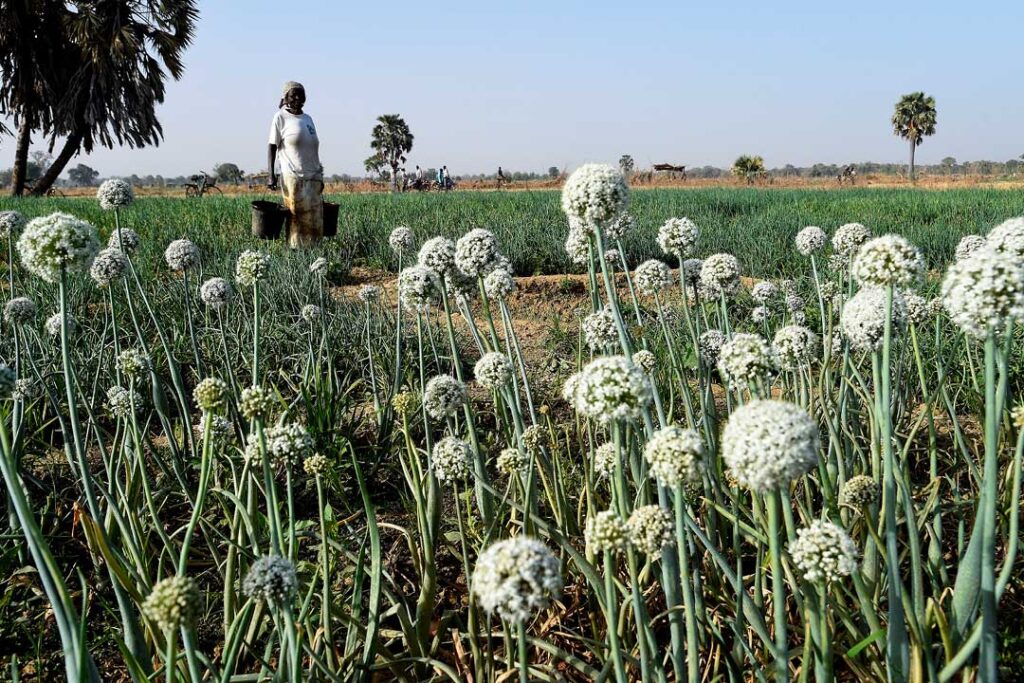Togo, a nation where agriculture accounts for more than 40% of GDP and employs over 65% of its workforce, is pursuing an ambitious vision of greater agricultural productivity and food self-sufficiency through what it calls Planned Agricultural Development Zones (ZAAP).
In a move aimed at boosting harvests and improving living standards, particularly in rural and peri-urban areas, Togo is on course to establish 400 of these zones by 2025, which are designed to focus on specific strategic crops, including rice, sesame, cashew, corn, soy, and sorghum.
As of 2021-2022, Togo had already set up 130 zones nationwide, covering an area of 12,608 hectares, although according to performance assessments the government carried out last year, only a handful of these were fully operational.

Despite this, a recent government report said these agricultural developments were proving their worth. Farmers within these zones were achieving higher yields, the report said, with an average difference of 36% compared to those outside the zones. Notably, the gains were substantial for crops like sorghum (33.5%), maize (77.5%), rice (18.25%), and soy (30%). Additionally, the zones had boosted farmers’ profits, showing an average increase of 65% in promising sectors, including soybeans, corn, rice, and sorghum.
Yao Lombo, the director of the Togolese Institute for Agronomic Research (ITRA), told Africa in Fact that the essence of these zones lay in providing farmers with essential resources. “Farmers need good seeds, fertilisers, tractors, and expertise to enhance their agricultural production. Through this initiative, farmers within the same zone are united, receiving comprehensive support from the state for cultivating specific food products,” he explained.
The pivotal role of mechanisation and intelligent agriculture cannot be understated. By clustering farmers together within these zones, Togo has successfully improved agricultural yields. This shift is attributed to the widespread deployment of tractors, consistent support from the Institute for Advice and Technical Support (ICAT), and cost reduction through consolidated orders of inputs and group sales of crops.
These initiatives have not only led to improved agricultural yields but also enabled farmers to attain food self-sufficiency, elevate their living standards, and invest in income-generating activities such as cattle breeding – 77.5% of farmers within the ZAAP have reported improvements in self-sufficiency. Agricultural activity in these zones has generated an average income of $658 per growing season compared to $480 outside the zones, a 36% increase in yields and income.

Amouzou Kokou, the chief of the canton of Essé Godjin in the prefecture of Yoto and a beneficiary of the planned agricultural development zones, is pleased with the programme. “It is a great joy for me that the government has taken it upon itself to develop an area of 100 hectares for us, it’s a brilliant idea,” he said. “In our canton, there is a cooperative that has been set up with a coordinator who will supervise everything. I grew okra on a small area due to lack of means to exploit a larger area, but this year we did several hectares and next year we will develop more, with peppers, lettuce, rice and tomatoes.”
In May this year, Togo also partnered with the Moroccan group OCP (Office Cherifien des Phosphates) to bolster its long-term agricultural policy. This collaboration aims to facilitate agricultural mechanisation services and local fertiliser production in Togo, building on their prior agreement in 2020 to develop soil fertility maps.
That agreement, the FERTITOGO project, under the leadership of the Togolese Institute of Agronomic Research, produced a fertility map covering almost the entire country. The fertility map was carried out in 38 out of 39 prefectures in the country and made it possible to introduce rational fertilisation techniques, based on precise knowledge of the soils and their fertiliser needs (mineral and organic fertilisers). This provided the nutrients necessary for crops while preserving the balance of ecosystems.
“Togo is the only country in the sub-region to have a fertility map covering almost the entire extent of its territory,” Lombo told Africa in Fact: “This new agricultural approach has enabled the country to record cereal surpluses for several years following the gradual establishment of the planned development zones across the country. The online map system not only assesses the land, but it also gives recommendations on crops and fertilisers based on the region’s average fertility and crop requirements.”
The success of this initiative is evidenced by the substantial increase in cereal surplus, from 70,000 tons in 2019-2020 to 179,000 tons in 2021-2022. Challenges remain, however, including the need for improved water management, a concern the government is actively addressing through a concurrent water management sub-programme.

Daoudou Salifou, an executive at the Ministry of Agriculture, said this programme was aimed at promoting smart agriculture and irrigation in all the country’s planned agricultural zones.
“Water management remains one of the challenges in these developed agricultural areas, a challenge for all the zones,” he told Africa in Fact. “However, the government is working to find a lasting solution to this.”
While the country has made significant strides in improving yields and livelihoods, achieving complete food self-sufficiency remains an aspiration. To help bridge this gap, Togo is also ambitiously creating agropoles—growth centres that aim to stimulate economic growth, generate employment, and enhance the link between agriculture and industry. The establishment of the first agropole (agricultural hub) in the northern region of Kara is a testament to this vision, uniting various stakeholders involved in agricultural production, processing, and marketing.
Located about 423 km from the Togolese capital, Lomé, and financed to the tune of $58 million, Kara brings together various actors involved in the production, processing, and marketing of agricultural products, among them 1,120 producers, including 274 women, operating in several planned agricultural development zones covering an area of 11,100 hectares. Going forward, the government plans to have 10 of these agropoles set up by 2030. The acting CEO of the national agency for the promotion and development of agropoles, Essowe Batana, said the agropoles represent a paradigm shift in the development of the Togolese economy.
Over the period 2023-2024, the country will intensify efforts in land development, agricultural mechanisation, water management, rural road construction, and the improvement of access roads. Innovative participatory approaches involving local authorities will secure land for development, and fertiliser orders will be optimised according to ecological zones. All in all, Togo’s agricultural transformation is gaining momentum, promising a brighter future marked by enhanced food security and economic growth.

Blame Ekoué is the Togo correspondent for the BBC and for Paris-based media house, ANA. He has also reported for Associated Press and Radio France International. He holds a BA in Communications from the Leader Institute in Lomé. Formerly deputy editor of the West Africa Revue, he has been a contributor to the Lome-based Business and Finance magazine since 2015.


